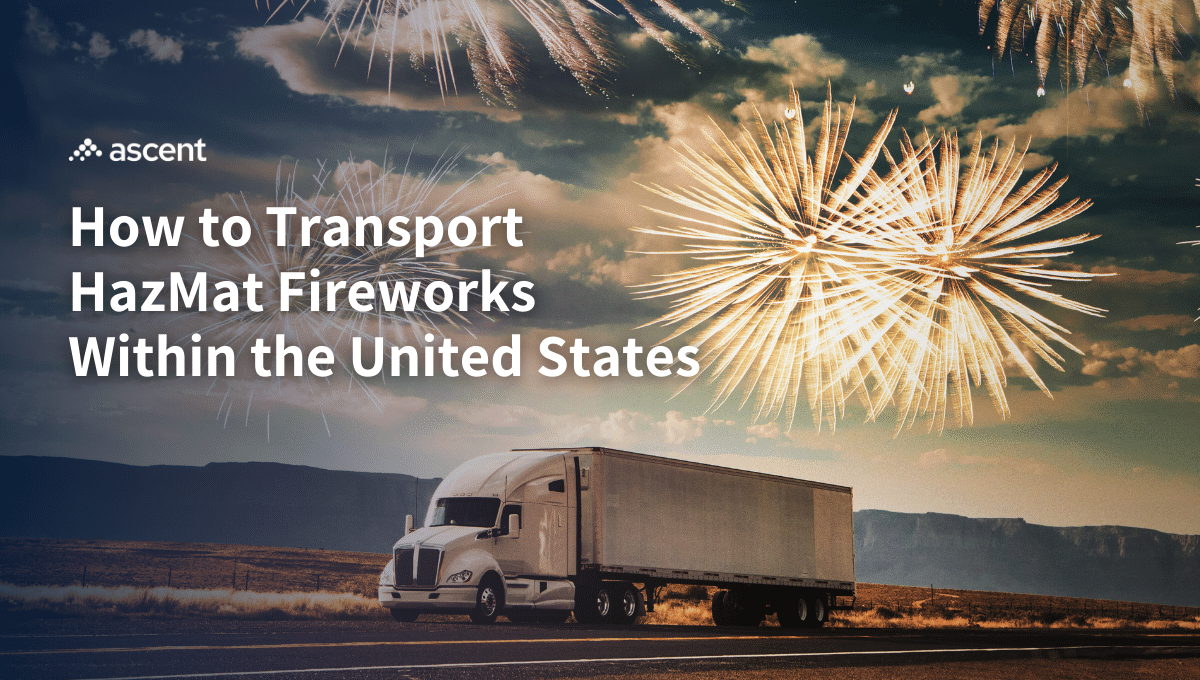How to Transport HazMat Fireworks Within the United States
05/16/2024

As the Fourth of July approaches, the demand for transporting fireworks surges. According to the American Pyrotechnics Association, over $2.3 billion worth of consumer and display fireworks are imported annually for Independence Day celebrations alone. However, with great spectacle comes great responsibility. Transporting these dazzling displays safely and legally demands strict adherence to hazardous materials regulations.
Understanding Fireworks Hazmat Class
Consumer fireworks are generally classified as HazMat Class 1.4G under hazardous regulations. Here’s a breakdown of what this classification means:
- – Class 1: This class is designed for explosives by the United Nations classification system for hazardous materials, which is adopted by regulatory agencies around the world, including the U.S. Department of Transportation (DOT).
- – Division 1.4: Within Class 1, Division 1.4 specifies explosives with a low risk of explosion. The main hazard in Division 1.4 is the production of a large number of flames rather than an explosion or blast. These are explosives that pose a minimal hazard in the event of ignition or initiation during transport.
- – G: The letter “G” in the classification (1.4G) stands for “articles.” This designation indicates that the hazardous material is in the form of manufactured articles (in this case, fireworks) rather than bulk substances.
Consumer fireworks classified as 1.4G include firecrackers, sparklers, bottle rockets, and other fireworks generally sold to the public for private use. These fireworks are designed to burn with flames and controlled explosions and are approved for consumer use because they pose minimal hazards compared to professional-grade fireworks, which might be classified under different divisions like 1.3.
Key Responsibilities of Fireworks Hauling
Shippers of hazardous materials, including fireworks, bear several critical responsibilities to ensure the safe transport of these substances. These responsibilities, outlined by the Federal Motor Carrier Safety Administration (FMCSA), encompass a range of tasks aimed at mitigating risks and maintaining regulatory compliance:
- – The material meets the definition of a “Hazardous Material”
- – Proper shipping name, class/division, and identification number
- – Hazard warning labeling
- – Packaging and marking
- – Employee training
- – Shipping papers
- – Emergency response information and telephone number
- – Compatibility
- – Blocking and bracing
- – Placarding
- – Security Plan
- – Incident Reporting
Carriers also have specific responsibilities when transporting hazardous materials like fireworks within the U.S., including:
- – Shipping papers are accurate and complete
- – Vehicles are placarded and marked, indicating the presence of hazardous materials
- – Safe loading and unloading of hazardous materials
- – Verify that hazardous materials are compatible with each other within the load
- – Proper blocking and bracing to prevent movement of hazardous materials
- – Report any incidents at the earliest practical moment
- – Develop and implement a security plan that addresses potential threats during transport
- – Provide thorough training for all employees involved in the transport of hazardous materials
- – Vehicles are suitable for transport and maintained in sound mechanical condition
- – Compliance with 49 CFR Part 397
Understanding the 9 Classes of Hazardous Materials
In the realm of hazardous materials transportation, it’s essential to grasp the classification system used to categorize different types of hazardous substances. The United Nations developed a system that divides hazardous materials into nine classes, each representing a distinct type of hazard. Familiarizing yourself with these classes, especially Class 1 explosives, can provide valuable insights into the nature of the materials being transported and the precautions necessary for safe handling.
Partnering with a HazMat Shipping Broker
For those unfamiliar with hazardous cargo regulations or seeking expert guidance, partnering with a HazMat shipping broker can streamline the transportation process. These professionals specialize in navigating complex regulatory frameworks and can ensure compliance every step of the way.
Choose Ascent as Your HazMat Logistics Partner
Safely and legally transporting fireworks requires meticulous attention to detail and a trusted partner. Ascent stands out in the industry with its proven track record of reliable hazardous materials transportation. With expertise in expedited shipping and an asset-backed approach boasting our own fleet of trucks and airlines, Ascent ensures your fireworks arrive safely and on time.
By choosing Ascent, you can expect timely deliveries, adherence to safety regulations, and personalized support throughout the transportation process. Don’t just take our word for it—our satisfied clients attest to the exceptional service they’ve received.
For further guidance on transporting fireworks or to tap into our HazMat shipping expertise, explore our Brokerage transportation solutions. Let Ascent be your reliable partner in ensuring your fireworks reach their destination safely and on time.
June 30, 2025
6 Reasons to Outsource Logistics
March 11, 2024
Thank you for contacting Ascent!
A member of our team will be in contact within a few business hours.
Okay